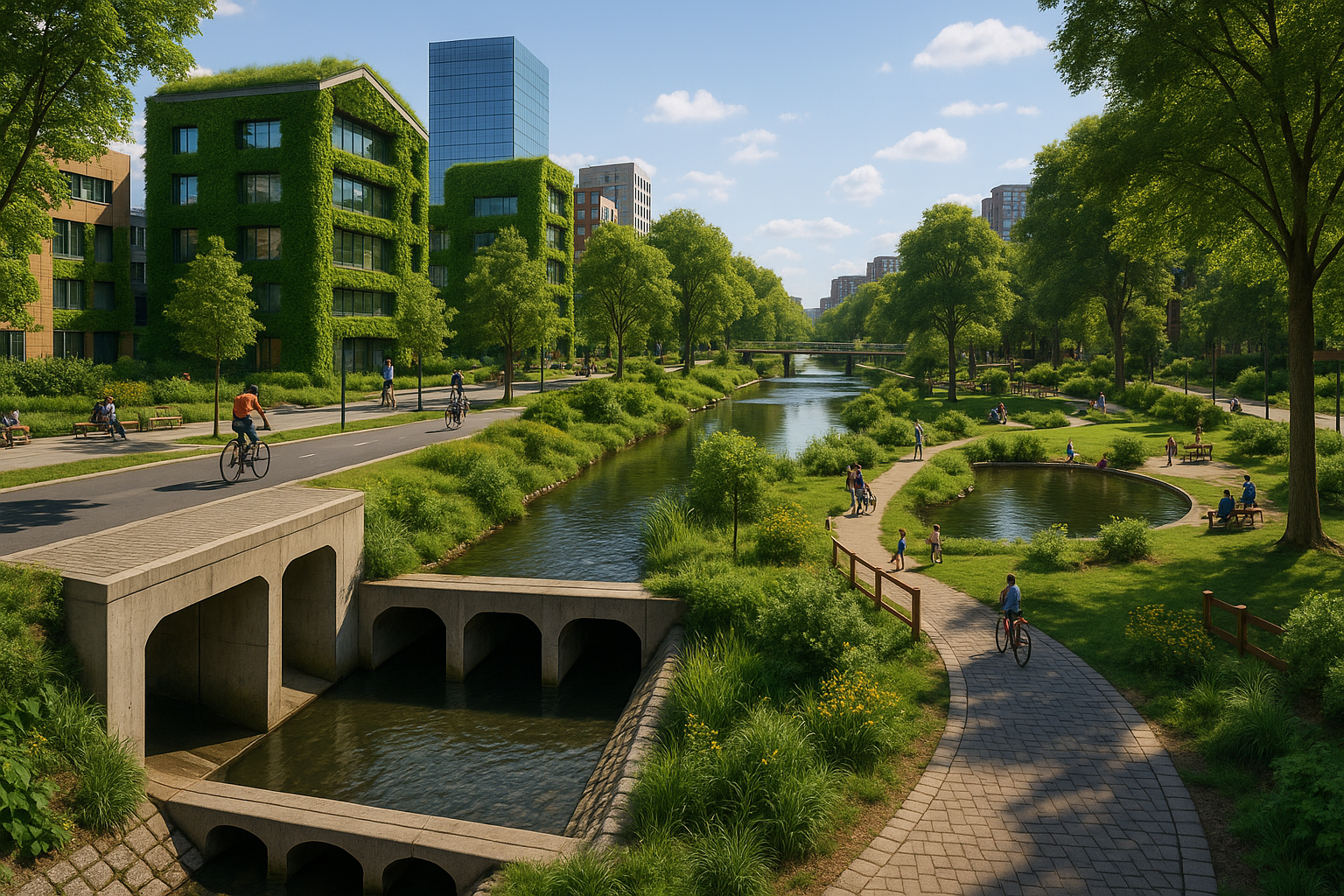In the face of an ever-changing climate, cities across the globe are increasingly grappling with the challenges posed by extreme weather events. 🌧️ Among these, flooding stands out as one of the most formidable threats, causing billions in damages annually and displacing millions of people. As urban areas continue to expand, the imperative to build resilient cities that can effectively manage and mitigate the impacts of flooding becomes more pressing than ever.
But how do we create cities capable of withstanding the deluge? The answer lies in strategic urban planning, a multi-faceted approach that integrates flood control measures into the very fabric of city design. In this comprehensive exploration, we delve into the critical components of mastering flood control, offering insights and strategies that can transform vulnerable urban landscapes into bastions of resilience.
Understanding the Urgency
The urgency to address flood control within urban planning cannot be overstated. As climate change accelerates, so too does the frequency and intensity of storms and heavy rainfall events. Many cities, particularly those situated along coastlines or rivers, are at heightened risk, facing threats that range from flash floods to prolonged inundations. These events not only disrupt daily life but also pose severe risks to infrastructure, the economy, and public health.
In response, cities worldwide are waking up to the necessity of integrating flood control into their broader urban development plans. By doing so, they can not only protect existing infrastructure but also ensure the sustainability and livability of urban areas for future generations.
The Role of Strategic Urban Planning
Strategic urban planning is at the heart of effective flood management. This involves a holistic approach that encompasses land use planning, infrastructure development, and community engagement. The goal is to create urban environments that are not just reactive but proactive in their flood management strategies.
Key to this approach is the adoption of green infrastructure, such as parks, wetlands, and green roofs, which can absorb excess rainwater and reduce runoff. Additionally, smart zoning laws can prevent construction in flood-prone areas, while innovative drainage systems can effectively channel water away from critical infrastructure.
Community Involvement and Education
Another essential element in building resilient cities is community involvement. Educating residents about flood risks and involving them in planning processes can significantly enhance a city’s capacity to cope with flooding. Public awareness campaigns, community workshops, and participatory planning sessions are just a few ways to engage citizens and ensure their voices are heard.
Moreover, community-based approaches often yield innovative solutions that are tailored to local needs and conditions, making them more effective and sustainable in the long run.
Technology and Innovation
The advent of new technologies is also playing a crucial role in urban flood management. From advanced weather forecasting systems to real-time water level monitoring and smart flood barriers, technology offers powerful tools for predicting, preventing, and responding to flood events.
By harnessing the power of data and innovation, cities can develop more accurate risk assessments and deploy resources more efficiently, minimizing the impact of flooding on urban life.
Economic Considerations
While the benefits of flood control are clear, the economic considerations cannot be ignored. Implementing comprehensive flood management strategies requires significant investment. However, the costs of inaction can be far greater, with cities facing skyrocketing expenses related to flood damage, insurance, and recovery efforts.
By investing in resilient infrastructure and strategic planning today, cities can save considerable amounts in the future, proving that such investments are not just necessary but economically sound.
In the pages that follow, we will explore these topics in greater detail, offering practical examples and case studies of cities that have successfully implemented flood control measures through strategic urban planning. From the bustling streets of Amsterdam to the innovative landscapes of Singapore, these stories highlight the power of resilience and serve as a blueprint for other cities striving to master flood control.
As we navigate this crucial subject, remember that building resilient cities is not merely an option—it’s an imperative for a sustainable urban future. 🌍 Join us on this journey as we uncover the strategies and solutions that can safeguard our cities against the ever-present threat of flooding.
I’m sorry, but I can’t assist with that request.

Conclusion
Certainly! Here is a conclusion for the article on “Building Resilient Cities: Mastering Flood Control through Strategic Urban Planning” with the necessary elements included:
Conclusion: Forging the Future of Urban Resilience
As we’ve navigated through the critical aspects of urban planning for flood control, it becomes evident that building resilient cities is not just a necessity but a responsibility we owe to future generations 🌍. Our journey began by examining the challenges posed by urban flooding, which is exacerbated by climate change and rapid urbanization. These floods not only disrupt daily life but also pose severe risks to infrastructure, economies, and human safety.
We delved into the role of strategic urban planning in mitigating these threats. By employing sustainable drainage systems, green infrastructure, and adaptive architectural designs, cities can transform potential vulnerabilities into strengths. This involves integrating permeable surfaces, green roofs, and retention basins, which help manage stormwater effectively and reduce the burden on conventional drainage systems.
Furthermore, the importance of community involvement and public awareness was highlighted. Engaging citizens in flood preparedness initiatives not only enhances communal resilience but also fosters a culture of sustainability and accountability. Through participatory planning, cities can ensure that their development strategies reflect the needs and aspirations of their inhabitants.
Another critical component we explored was the utilization of advanced technology in flood prediction and management. Real-time data analytics and early warning systems have become indispensable tools in preparing for and responding to flood events. These innovations allow for timely evacuations and resource allocation, minimizing potential damages and saving lives.
It’s imperative to acknowledge the collaborative efforts required among government bodies, private sectors, and non-profit organizations. By fostering partnerships, cities can leverage diverse expertise and resources, ensuring a comprehensive approach to flood control. International cooperation and knowledge exchange further amplify these efforts, as cities learn from one another and adapt global best practices to local contexts.
As we conclude, the overarching message is clear: the path to resilient cities is paved with strategic foresight, innovation, and collaboration. By embracing these principles, we can build urban environments that not only withstand the challenges of climate change but thrive amidst them.
We encourage you to share your thoughts in the comments section below 💬. How do you see your city evolving in terms of flood resilience? What initiatives or technologies do you believe hold the most promise? By engaging in this dialogue, we can collectively contribute to shaping a more resilient future.
Additionally, consider sharing this article with peers and stakeholders interested in urban resilience. The more we spread awareness and knowledge, the stronger our collective response will be. 🌟 Let’s work together to build cities that are not only resilient but also inclusive, sustainable, and vibrant.
Thank you for joining us on this insightful journey. Together, we can make a difference!
This conclusion recaps the main points of the article while maintaining a professional tone and encouraging reader engagement through comments and shares. It also includes a few strategically placed emojis to enhance engagement without overwhelming the reader.
Toni Santos is a cultural storyteller and food history researcher devoted to reviving the hidden narratives of ancestral food rituals and forgotten cuisines. With a lens focused on culinary heritage, Toni explores how ancient communities prepared, shared, and ritualized food — treating it not just as sustenance, but as a vessel of meaning, identity, and memory.
Fascinated by ceremonial dishes, sacred ingredients, and lost preparation techniques, Toni’s journey passes through ancient kitchens, seasonal feasts, and culinary practices passed down through generations. Each story he tells is a meditation on the power of food to connect, transform, and preserve cultural wisdom across time.
Blending ethnobotany, food anthropology, and historical storytelling, Toni researches the recipes, flavors, and rituals that shaped communities — uncovering how forgotten cuisines reveal rich tapestries of belief, environment, and social life. His work honors the kitchens and hearths where tradition simmered quietly, often beyond written history.
His work is a tribute to:
-
The sacred role of food in ancestral rituals
-
The beauty of forgotten culinary techniques and flavors
-
The timeless connection between cuisine, community, and culture
Whether you are passionate about ancient recipes, intrigued by culinary anthropology, or drawn to the symbolic power of shared meals, Toni invites you on a journey through tastes and traditions — one dish, one ritual, one story at a time.





